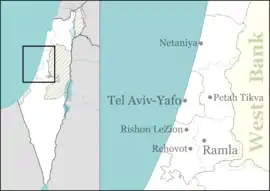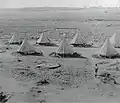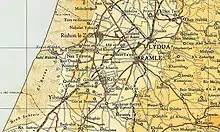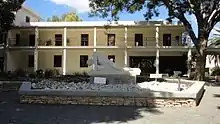Givat Brenner
Givat Brenner (Hebrew: גִּבְעַת בְּרֶנֶר, lit. Brenner Hill; Arabic: غفعات برينر), is a kibbutz in the Central District of Israel. Located around two kilometres south of Rehovot, it falls under the jurisdiction of Brenner Regional Council. Founded in 1928, it is named after writer Yosef Haim Brenner, who was killed in the Jaffa riots of 1921. In 2019 it had a population of 2,678.[1].It is the largest kibbutz in Israel.
Givat Brenner
גִּבְעַת בְּרֶנֶר | |
|---|---|
 | |
 Givat Brenner | |
| Coordinates: 31°51′52.19″N 34°48′1.08″E | |
| Country | Israel |
| District | Central |
| Council | Brenner |
| Affiliation | Kibbutz Movement |
| Founded | 1928 |
| Founded by | Jewish immigrants from Lithuania, Poland and Germany |
| Population (2019)[1] | 2,678 |
| Website | www.gbrener.org.il |
History
Givat Brenner was founded in 1928 by Enzo Sereni[2] and a group of immigrants from Lithuania, Poland and Germany. That same year, pioneers had settled on some 200 dunams (49.4 acres) of land that had been purchased by Moshe Smilansky from the Arab landholders of Aqir and Zarnuqa.[3] During World War II, Givat Brenner supplied products such as jam to the British Army, which laid the foundation for its export business.
 Givat Brenner 1928
Givat Brenner 1928_-_Kibbutz_Givat_Brener.jpg.webp) Kibbutz Givat Brenner, 1935
Kibbutz Givat Brenner, 1935 Food canning factory, Givat Brenner, 1939
Food canning factory, Givat Brenner, 1939 Givat Brenner 1945 1:250,000
Givat Brenner 1945 1:250,000 Givat Brenner 1:20,000
Givat Brenner 1:20,000 Members of Company H, Palmach, in Giv'at Brenner, 1945
Members of Company H, Palmach, in Giv'at Brenner, 1945
The establishment of an irrigation equipment factory led to the creation of a foundry. The foundry evolved into a specialized aluminum die-casting company, which has produced, among other things, the housings for emergency phones along the New Jersey Turnpike. In 1938, it opened the first kibbutz sanatorium in the country.[4]
Demographics
According to a census conducted in 1931 by the British Mandate authorities, Givat Brenner had a population of 155 inhabitants and a total of 5 residential houses.[5] In 1970 the population was 480.[6]
Education
Givat Brenner Regional School serves the communities of the Brenner Regional Council. The offices of the Regional Council are also located in the Kibbutz.
Economy
Givat Brenner's plant nursery supplies turf for lawns and parks. The kibbutz grows cotton, avocado, wheat and corn, and maintains a dairy farm. Industrial ventures include a furniture factory, metalwork factory, canned foods plant and an irrigation equipment factory, which gradually shut down for financial reasons. The 'House of Dreams' amusement park was established to offset waning income from the orchards, plant nurseries and factories, but was eventually closed.[7]
Landmarks
The Treasure Museum, in the heart of the kibbutz, opened on the Givat Brenner's seventieth anniversary. It houses a collection of artifacts and photographs that tell the story of the kibbutz pioneers.
Notable residents

- Aharon Megged, author
- Achi Brandt, mathematician noted for pioneering contributions to multigrid methods
- Yitzhak Sadeh, writer and Haganah officer
- Jessie Sampter, poet, close friend of Hadassah founder Henrietta Szold, established a vegetarian convalescent home on the kibbutz in 1938.
References
- "Population in the Localities 2019" (XLS). Israel Central Bureau of Statistics. Retrieved 16 August 2020.
- "Enzo Sereni". Jewish Virtual Library.
- Compton, Israelah (1979). "Givat Brenner". Israel Guide - Sharon, Southern Coastal Plain and Northern Negev (A useful encyclopedia for the knowledge of the country) (in Hebrew). 6. Jerusalem: Keter Publishing House, in affiliation with the Israel Ministry of Defence. p. 116. OCLC 745203905.
- Riba, Naama (20 May 2016). "How Israel's socialist retreats for workers turned into luxury hotels". Haaretz. Retrieved 25 April 2019.
- Mills, 1932, p. 20
- "Israel Place List (1970)" in Encyclopedia Judaica. 1. New York: Macmillan, p. 176.
- Sanior, Eli (18 September 2003). קיבוץ גבעת ברנר נדרש להרוס את "בית חלומותי" [Kibbutz Givat Brenner forced to demolish 'House of Dreams']. Yedioth Ahronoth (in Hebrew). Retrieved 25 April 2019.
Further reading
- Gavron, Daniel. The Kibbutz: Awakening from Utopia. Lanham, MD: Rowman & Littlefield, 2000.
External links
| Wikimedia Commons has media related to Givat Brenner. |
- Official website (in Hebrew)
- From Socialist Dream to Capitalist Reality New York Times, April 1998
- http://www.givat-brenner.co.il Givat Brenner website
